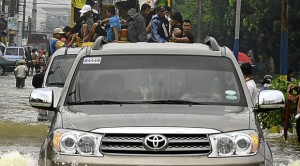MANILA, Philippines – Manila’s creaking train network means a miserable three-hour work commute for salesman Gerard Galang – just one example of major infrastructure woes that analysts say threaten to cool the Philippines’ red-hot economy.
Peak-hour hell comes in many forms in the city of 12 million people, with commuters experiencing a sweaty, stinky crush on dilapidated trains and giant queues to buy tickets.
“I pity myself and my fellow commuters but I don’t have any other option than the train,” said Galang, 29, who inhales antiseptic rubbed on to his hands to help negate the stench on the train.
“It gets so crowded our faces get pressed against each other and on doors and windows.”
Galang spends three hours commuting to work every day, half of which is spent in queues.
For other commuters on buses or in cars, daily gridlock worsens to a complete standstill that can trap people for hours when even small rain storms trigger flash floods.
The Philippine economy has in recent years shed its reputation as one of Asia’s laggards, with growth of 6.4 percent in the second quarter maintaining its status as the region’s best performing after China.
The country also recently gained its first investment grade scores from the big three global credit rating agencies.
Urban decay
Infrastructure development, however, hasn’t moved at the same pace, and economists warn the creaking systems that are of so much frustration to millions of people will also have a growing impact on economic growth.
“Our facilities are not built for an economy that is growing at seven percent every year,” Ronald Mendoza, a senior economist at the Asian Institute of Management, in Manila told AFP.
Mendoza said growth could have been faster had it not been for the ageing airports and road networks that turn off foreign investors and tourists, and limit the movement of local trade.
Manila already loses 2.4 billion pesos ($53 million) in potential income daily due to traffic jams, according to a study by the Japan International Cooperation Agency.
Among the other infrastructure problems are power shortages that lead to brownouts, clogged drainage that exacerbate frequent rainy season floods and an Internet network so slow that it sparked a parliamentary enquiry.
Millions of people in slums, and even some residents of middle class districts, do not have access to running water.
And Manila’s decades-old international airport, with malfunctioning air conditioning and leaking toilets, has been cited by a travel website as the worst in the world.
No quick fix
President Benigno Aquino and his team are acutely aware of the problems.
“Sustaining the economy’s high-growth trajectory requires continued investment in infrastructure,” Economic Planning Secretary Arsenio Balisacan told Japanese businessmen last week.
The government is planning to increase infrastructure spending from 2.2 percent of gross domestic product in 2012 to five percent by the end of Aquino’s term in 2016.
As part of that, the government will pursue its so-called public-private partnership program. More than 50 projects are being put out to private builders.
Balisacan also said implementing a 2.6-trillion-peso ($58 billion) “dream plan” drafted by the Japan International Cooperation Agency was a top priority.
The agency’s plan calls for an expansion of rail and toll road networks to provinces north and south of Manila, spreading economic activity, as well as a subway system for the capital.
It also envisages a new Manila airport terminal.
Many of the projects cited by the Japanese plan are included in the PPP pipeline, but these have moved painfully slowly due to regulatory delays and court cases between rival bidders.
Fewer than 10 contracts for the public-private partnership programme have been awarded during Aquino’s first four years in office, with no projects yet completed.
And while Aquino’s intentions are laudable, there is only a limited amount it can do before his term ends in the middle of 2016, according to Mendoza.
“Many of these projects are perfectly doable, especially the airports and toll roads,” Mendoza said.
“What’s needed is a multi-administration plan… many of them take up to three administrations to finish.”
Philippine leaders are elected to single, six-year terms, raising continuity problems.
Manila residents, in the meantime, have little choice but to count the personal cost of the urban decay.
Jury Domino, who owns a catering business, said ever-growing delivery times eat into his profits — with his vans held hostage for hours guzzling fuel in traffic and staff having to be paid overtime.
“It’s a big hassle, expenses rise every month and the problems pile up,” he said.
RELATED STORY
PH gov’t looking into traffic, flood problem
